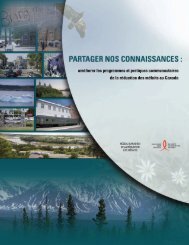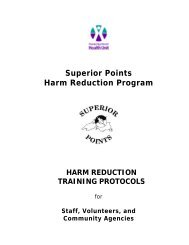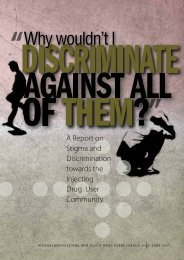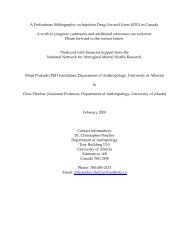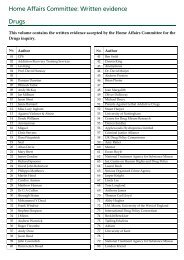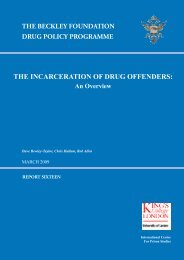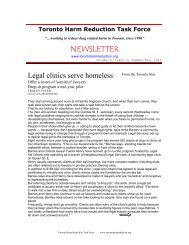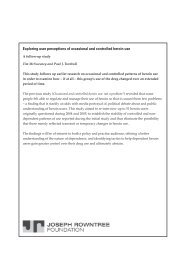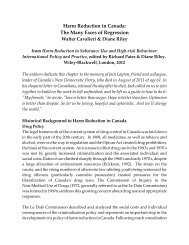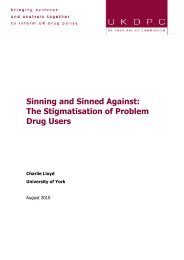Canadian Journal Addiction Medicine - Canadian Harm Reduction ...
Canadian Journal Addiction Medicine - Canadian Harm Reduction ...
Canadian Journal Addiction Medicine - Canadian Harm Reduction ...
Create successful ePaper yourself
Turn your PDF publications into a flip-book with our unique Google optimized e-Paper software.
Community-based Naloxone: A <strong>Canadian</strong><br />
Pilot Program<br />
November 2012<br />
Kathryn A. Dong MD, MSc, FRCP, DABEM 1,2<br />
Marliss Taylor BScN 2,3<br />
Cameron T. Wild PhD 2,3,4<br />
Cristina Villa-Roel MD, PhD (candidate) 1,4<br />
Mat Rose MD, CCFP 2,5,6<br />
Ginetta Salvalaggio MD, MSc, CCFP 2,6<br />
Brian H. Rowe MD, MSc, CCFP(EM) 1,2,4<br />
1<br />
Department of Emergency <strong>Medicine</strong>, Faculty of <strong>Medicine</strong> and Dentistry,<br />
University of Alberta, Edmonton, AB; 2 Edmonton Inner City Health<br />
Research and Education Network, Edmonton, AB; 3 Streetworks Needle<br />
Exchange Program, Boyle Street Community Services, Edmonton, Alberta;<br />
4<br />
School of Public Health, University of Alberta, Edmonton, Alberta;<br />
5<br />
Boyle McCauley Health Centre, Edmonton, Alberta; 6 Department of<br />
Family <strong>Medicine</strong>, Faculty of <strong>Medicine</strong> and Dentistry, University of Alberta,<br />
Edmonton, AB<br />
Address for Correspondence and Reprints: Dr. Kathryn A. Dong, Room<br />
565 CSC, Royal Alexandra Hospital, 10240 Kingsway Avenue, Edmonton,<br />
Alberta, Canada T5H 3V9<br />
Phone: 780-735-5374, Fax: 780-735-4916, E-mail: kathryni@ualberta.ca<br />
Presentations: This work was presented as a poster at the <strong>Canadian</strong><br />
Association of Emergency Physicians Annual Scientific Conference in<br />
Calgary, Alberta in June 2009 and the Society for Academic Emergency<br />
<strong>Medicine</strong> Annual Conference in May 2009 in New Orleans, LA<br />
Funding: Health Canada<br />
Conflicts of Interest: None to Declare<br />
Abstract<br />
Objectives: This study was designed to gather data on the<br />
implementation of community-based naloxone delivery for<br />
opioid overdose in a <strong>Canadian</strong> setting.<br />
Participants: A convenience sample of 50 clients accessing a<br />
needle exchange program for harm reduction supplies.<br />
Setting: This program took place in an urban <strong>Canadian</strong> city<br />
and was based out of a needle exchange program.<br />
Intervention: After written, informed consent was obtained, all<br />
participants were trained in overdose recognition, artificial<br />
respiration, naloxone administration and emergency medical<br />
services (EMS) activation.<br />
Outcomes: Most participants were male (30, 60%) and the<br />
average age was 45.1 years (±8.6 years). The majority (40,<br />
80%) used opioids either daily (36, 72%) or weekly (4, 8%).<br />
Most (39, 78%) had experienced an overdose themselves<br />
and the vast majority (46, 92%) had witnessed someone else<br />
overdose. Over the 20-month study period, naloxone use<br />
was reported nine times. It was most often administered in<br />
a private residence (4, 44%). It was administered to another<br />
individual in eight cases; one person self-administered<br />
naloxone. Artificial respiration was provided in four cases, and<br />
a clean needle and syringe were used in all cases; EMS was<br />
activated in only one case. No adverse reactions and no deaths<br />
after naloxone use were reported.<br />
Conclusions: Community-based naloxone programs can be<br />
implemented in a <strong>Canadian</strong> setting and have the potential<br />
to reduce the morbidity and mortality associated with opioid<br />
overdose. Significant barriers to activating EMS still exist in<br />
this setting.<br />
Introduction<br />
The morbidity and mortality associated with illicit drug misuse<br />
is high and appears to be increasing in Canada (1, 2). In<br />
addition to the health consequences, illicit drug use also incurs<br />
health care system costs including emergency medical services<br />
(EMS) activation, emergency department (ED) visits, and<br />
hospitalization. The financial costs associated with illicit drug<br />
misuse were estimated at $262 (Can) per capita in 2002 (2).<br />
There are over 80,000 regular illegal opioid users in Canada<br />
(3) and in 2002 the number of opioid related overdose deaths<br />
in Canada was estimated to be 958. The province of Alberta<br />
has the highest rate in Canada with over double the national<br />
average of overdose deaths (12.9 vs. 5.9 overdose deaths per<br />
100,000 population age 15-49 years) (3). Recent concerns<br />
about the rising non-medical use of prescription opioids have<br />
also been identified (4, 5).<br />
Naloxone quickly reverses the respiratory depression and<br />
progressive hypoxia associated with opioid overdose and is<br />
associated with minimal side effects (6). Community-based<br />
naloxone programs - advocated as one approach to mitigate<br />
the effects of overdose - train active opioid users to recognize<br />
overdose signs, provide basic life support, administer naloxone<br />
and activate EMS (7, 8). Such programs have been successfully<br />
implemented in the United States (9 – 13), United Kingdom<br />
(14), Germany (14) and Italy (15); however, in Canada, delivery<br />
of naloxone almost always depends on access to health care<br />
providers.<br />
While these programs are controversial (16, 17), several studies<br />
have demonstrated that opioid users can be successfully trained<br />
in overdose recognition and appropriate naloxone use (18, 19).<br />
Such community-based programs have reported successful<br />
reversal of opioid overdoses after naloxone administration<br />
(9, 13). Support in the drug using community is high (70-<br />
90%) (20 – 22); over 80% of participants accessing a needle<br />
exchange program in one <strong>Canadian</strong> city were supportive of<br />
4



